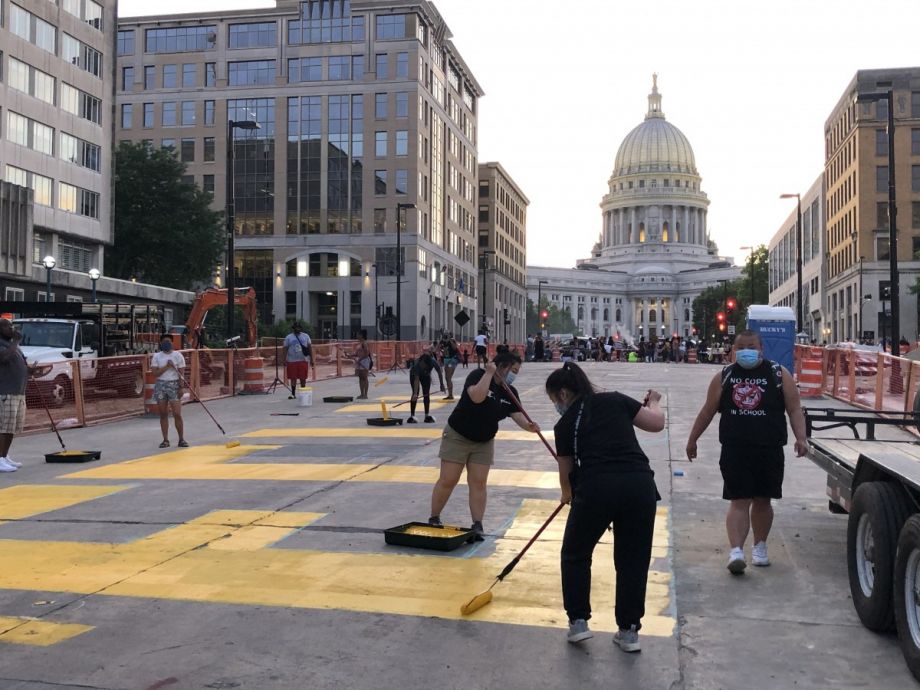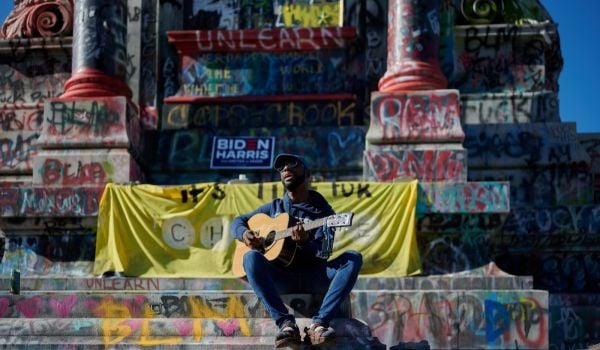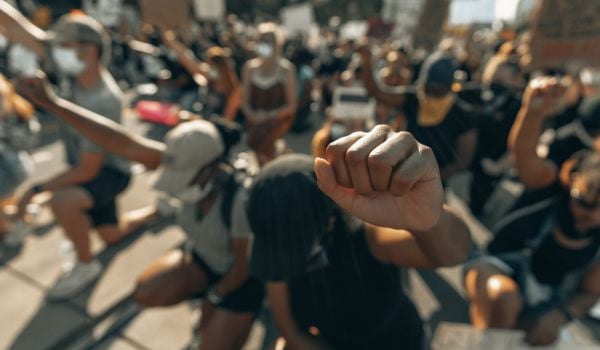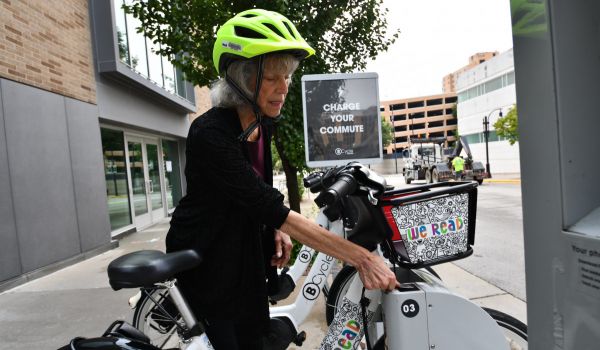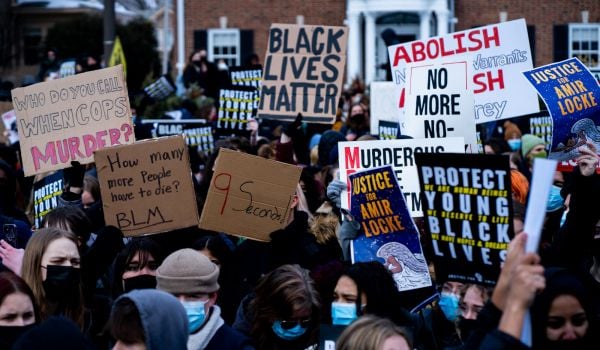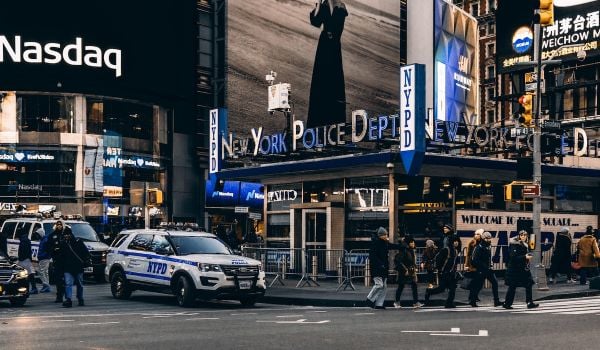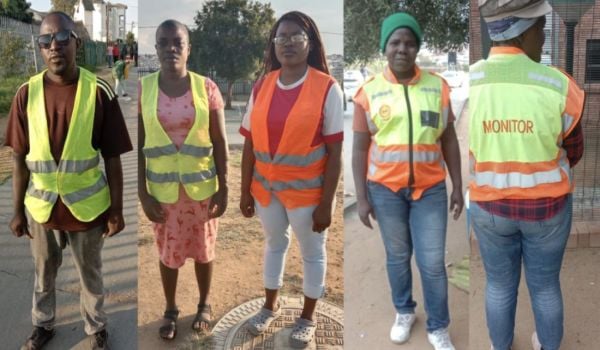A few dozen people sat on the grass near the State Capitol building enjoying the last rays of the sun while others prepared a sound system on the corner. The day was Breonna Taylor’s birthday, and demonstrators had come out to celebrate her life and to call for an end to police violence. A long, folding table stood against the wall between the sidewalk and the capitol lawn, laden with pizza, sandwiches and water donated by local businesses. Masked-up volunteers handed sustenance to those who approached the table. Others were ready to help passersby register to vote. Across the street, shops boarded up with plywood recalled the unrest that had disrupted the downtown area a week earlier.
As night settled in, the sound system first pumped music. Later, young people took the mic and spoke about Taylor and the urgency of shifting money away from policing and into community programs. The voices came from a new generation of activists, and their protests have drawn attention.
The first mass gathering in Madison to protest George Floyd’s murder took place on May 30. It’s unclear what sparked unrest hours later, but the night saw a small group of mostly young, white people smashing store windows and looting shops on the city’s downtown pedestrian mall. Police used pepper spray and tear gas to try to quell the destruction. Mayor Satya Rhodes-Conway issued a state of emergency order and a 9:30 p.m. curfew, but the next few days repeated the same cycle of peaceful gatherings followed by nights of vandalism.
The city’s Common Council, however, refused to extend the Mayor’s emergency order, effectively ending it and the related curfew days later. Alderwoman Donna Moreland was one of those who voted against the order, saying: “This is about people knowing that there are bad eggs in their (police) department and letting it go on.” Local activists also opposed the curfew, arguing that curfews are simply a way to criminalize being outside, and that they lead to Black and brown people being arrested.
Lifting the curfew enabled young people to take to the streets, and the night after the council meeting, hundreds converged on the capitol for a peaceful vigil. The transformation has drawn attention to the protesters’ ability to self-govern.
“We have a safety team that ensures the safety — and wellness — of all the people who decide to join us,” Bianca Gomez, 30, told Next City at another rally a few days later. Gomez is the Youth Justice Director at Freedom, Inc., a social justice organization that works with Black and Southeast Asian Madisonians. Gomez spoke while others painted “defund police” in yellow block letters on the street in front of the building where the common council meets. Further up the street, grills spewed smoke and the scent of hamburgers.
Freedom, Inc. carefully selects the people it invites to participate in safety trainings. Those trainings aim to equip the participants to act as a safety team during demonstrations. Training participants learn techniques in de-escalation as well as how to interact with the police. White allies, Gomez says, learn how to “act as a barrier between us and the police and what it means to truly be an ally and co-conspirator and put your body on the line.”
Before each protest, the group also prepares a care team and medics to assist people who may have problems during a demonstration, such as dehydration.
At an event during the first week of June, a white man armed with an assault rifle confronted the demonstrators. The safety training enabled the demonstrators to avoid violence.
“We had our allies form a barrier, and we got our people out as soon as we could,” says Gomez. “Obviously, we don’t want to escalate. They are looking to provoke people, to have a reason to use their white supremacist violence, their physical violence, against our people,” she told Next City.
The strategy reflects a commitment to protecting life and to avoiding police involvement. Those represent core values of the prison abolition movement, which calls for addressing social issues through restorative and transformative practices rather than punitive ones. That movement has also popularized the call to move resources away from policing and prisons and into community services.
The armed man wasn’t the only act of aggression the demonstrators have had to deal with. On the first day of protests, a white woman in a car hit a marcher who was on a bicycle. Other participants surrounded her car, but organizers say she pushed through the crowd and police allowed her to leave. Joel Despain, a spokesperson for the Madison Police Department, said that a motor vehicle crash report had been filed about the incident and that the officer who filed the report said the case would “require further review for appropriate charging decisions.”
Teeanna Brisco, 22, graduated from a Madison High School in 2015 and is now studying law at Howard University. She returned home from Washington, D.C. after participating in the first week of demonstrations there following George Floyd’s murder.
“I think on every level of what I’ve witnessed happening has been the youth organizing: from the demonstrations to the traffic stops,” Brisco says. In her own circle of friends and beyond, she says, there has been “a ton of conversation” around “what is appropriate to do to get justice.” What has come through clearly, she says, in these conversations is the sentiment “even if you fight your fight differently than I do, I’m still on your side before anybody else’s.”
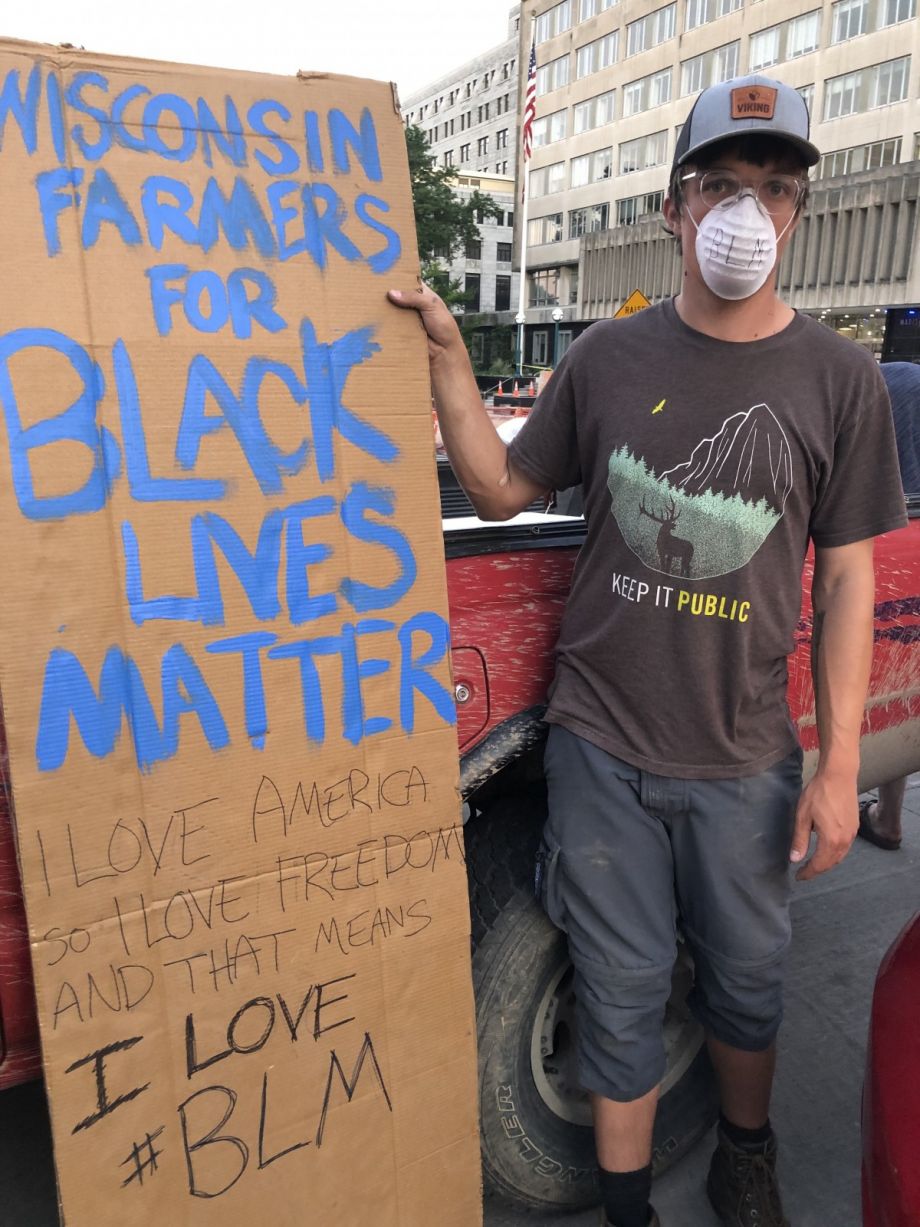
Farm worker Dylan Bruce stands with the truck he used to help protesters march safely. (Photo by Zoe Sullivan)
Brisco penned an op-ed in a local newspaper criticizing Madison’s Boys and Girls’ Club for announcing its hiring of 75 “peacekeepers” who would participate in demonstrations as a sort of calming force by distributing water and de-escalating tensions. Those people would have to be at least 21 years old. Brisco argued that there were already young people doing the policing work day in and day out at the demonstrations. She also questioned the wisdom of having people focused on defusing tension.
“The tension is not really something that needs to be eliminated or defused because it’s in the tension that people have tough conversations that need to be had or step aside and talk to someone they never would have spoken to before if not for the event,” Brisco says.
Although Madison police did help manage traffic during a Sunday march with thousands of people, to prevent future episodes like the woman hitting the bicyclist, Black Lives Matter organizers have also recruited help from supporters. For example, Dylan Bruce, 27, has a truck and works on a farm two hours west of Madison. He used his truck to block the road so marchers could walk during a weekday demonstration without fear of being run over.
“They needed somebody to block traffic, and I said O.K.,” Bruce says. He told Next City that he wanted to support the movement and show solidarity.
Brisco says while she has felt disappointed in the actions of public officials and older generations, she has seen many actions like Bruce’s. “What I’ve seen in my Madison experience and in my D.C. experience is young people keeping other young people safe,” she says.

Zoe Sullivan is a multimedia journalist and visual artist with experience on the U.S. Gulf Coast, Argentina, Brazil, and Kenya. Her radio work has appeared on outlets such as BBC, Marketplace, Radio France International, Free Speech Radio News and DW. Her writing has appeared on outlets such as The Guardian, Al Jazeera America and The Crisis.
Follow Zoe .(JavaScript must be enabled to view this email address)

